On Monday (20th April) the Scottish Parliament met, sitting two metres apart. The session started with the Presiding Officer asked MSPs to take particular care to maintain that distance when arriving and leaving at the Chamber. That same day the First Minister announced a crackdown on workplaces that had been allowed to remain open but which were not ensuring that staff were able to keep 2m apart – quite right too. Maintaining physical distance is THE crucial factor in preventing the replication of COVID-19 and the spread of the pandemic. Then yesterday, the Scottish Government not only used the term “physical distancing” (rather than social distancing) it emphasised how important this will be get out of the crisis. All positive steps in the right direction.
Unfortunately, however, in recognising the key role of physical distancing, the Scottish Government has not yet accepted the converse, which is that there is almost no justifiable need to restrict what people do or where they can go if they can keep 2m apart. That is the case for almost all work and recreational activities which take place outdoors. Instead, the Government has remained fixated on promoting the Stay at Home message which was designed in and for London. That has just fed the irrational fears about the virus, with increasingly adverse consequences.
The health consequences of the stay at home message
The stay at home message is contrary to the reams of government strategy, policy and guidance documents about the importance of walking and being outside for both physical and mental health. The consequence of the government breaking its own advice is that confining people to where they are living has numerous adverse short-term and longer-term consequences, from suicide to diseases associated with obesity. These problems will NOT suddenly be solved by lockdown being lifted, whether that is in 3, 6 or 12 weeks because what people are physically able to do and how they perceive the world is being affected by the lockdown. When lockdown ends, it’s likely many people will still be too frightened to go out sufficiently frequently and that is likely to be even more the case if, as the Scottish Government is now arguing, further lockdowns may be needed.
The consequences of that fear are best seen at present in the huge decrease in people seeking treatment from the NHS. Many people are not even attending the appointments that are being offered, they are not taking themselves to A and E and not referring themselves to the NHS when they start to experience symptoms (see here). The immediate consequence has been a spike in deaths following the lockdown (see here), which a few days ago the Sun speculated might be due to people with alcohol and drugs problems not getting treatment (see here). The Herald yesterday amplified these concerns, reporting that in Scotland there had been 886 additional deaths between 30th March and 19th April, not attributable to Covid-19, including 167 caused by strokes/heart disease, 279 to dementia and 161 to cancer. The longer-term consequences of people not being treated timeously for illnesses like cancer and heart disease remain to be seen.
There is a connection between this additional health disaster and the clampdown on access to the countryside. One of the main arguments that has been used for trying to stop people in Scotland driving to the countryside is that people doing so might have an accident and that would put an intolerable strain on the NHS. The current under-utilisation of the non-Covid facilities of the NHS disproves that. But the arguments that it’s irresponsible to drive, because you might have a crash, and require Aa nd E services, or irresponsible to walk, because you might have an accident and call out the mountain rescue, while sometimes well-intentioned, have both been shown to be invalid and have also contributed to the lack of people seeking non-Covid treatment. These public statements on driving and venturing into the hills have created a disastrous atmosphere in which many people feel ashamed about seeking medical treatment of any sort in hospital departments dealing with non- Covid illnesses or accidents.
At the same time the arguments that you might catch COVID-19 by touching a park bench or a gate have contributed to the perception that the risk of catching the virus in these situations is much higher than it is. That perception has helped create irrational fears. Such fear also deters people from seeking medical help when they really do need it (e.g they think its too dangerous to go to any hospital because they fear they will catch Covid 19 in any part of that hospital).
The panic in the countryside, which objectively is the safest place people could be, and panics about using green space in towns have unfortunately contributed to the increase in non-COVID-19 deaths. Government needs to clearly differentiate what is high risk and unsafe from what is low risk and relatively or completely safe.
Fear, farming and the lockdown
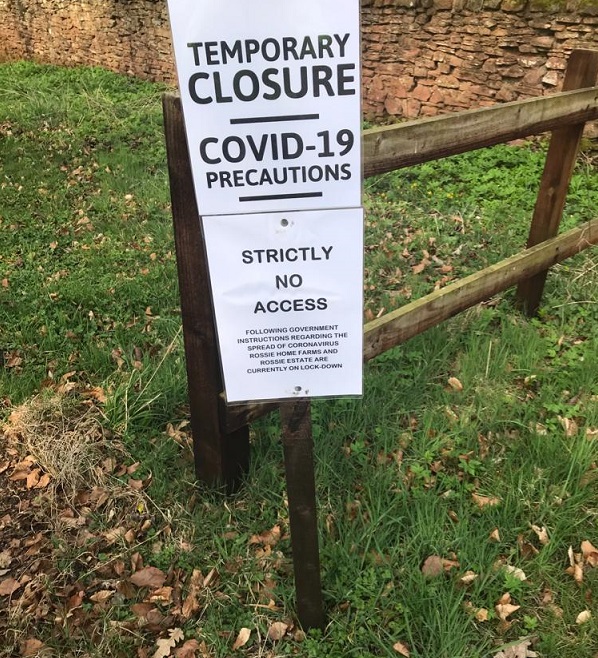
Some of the signs that have gone up trying to stop the public taking access in farmland have been prompted by irrational fears. For example, on 16th April there was coverage on BBC Good Morning Scotland and later radio/TV programmes about farmers concerned about public access and the complaints that the NFUS claimed they were getting from their members. These included risks that farmers claimed they are being exposed to from the public taking access over their land. (By comparison, in 40 years of walking I doubt I have come within 2m of a farmer more than a handful of times and that only when we both deliberately engaged in conversation).
However, soon after the lockdown began, the National Farmer’s Union of Scotland also started to claim that more people were visiting farm land and that farmers were experiencing more problems than usual. While there is evidence that the NFUs was deliberately stimulating these complaints,

nevertheless, they had picked up on a significant change in the pattern of access that has taken place in the last few weeks.
It was not that more people were visiting the countryside and ignoring the exhortations not to travel, rather the opposite. Many people who live in rural areas and on the urban fringe have, for the first time, been following government advice and been trying to walk from their backdoor. Hence the reported increase in numbers of people on farmland and also the issues with dogs. Instead of driving to their local woodland or nearby open country for a walk, people were trying to walk through fields from their homes.
This analysis is confirmed by the SNH in their guidance (see below) which states, at the very end of their advice to land managers:
“This [recommended good practice] is particularly important at this time when many people are using new and unfamiliar local areas for daily outdoor exercise.”
One solution to this might have been for the NFUs to have called on their members to unblock parking places and to have called on the government to encourage people to drive away from farmland to take exercise. Instead, they promoted increased restrictions, some of which are not compliant with the Scottish Outdoor Access Code (see here for background to poster) and in doing so have added to the panic:
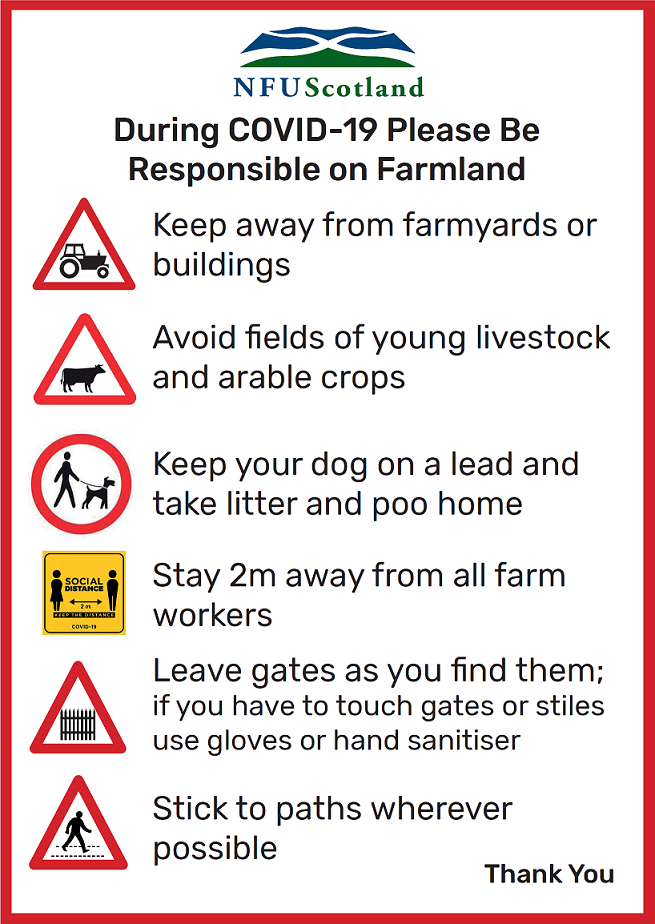
The NFUS posters (see here for links to all of them) are notable for their FAILURE to reference the Scottish Outdoor Access Code (SOAC) which contains extensive advice about access to farmland. Two of the bullet points are I believe well intentioned, that on keeping a 2m distance and how to reduce the risk of passing on the virus by opening gates. They do supplement what’s in SOAC. The other four points are an unjustified attempt to re-write SOAC. Dogs don’t transfer corona virus, nor will walking or cycling through a farmyard (whether there is a right of way or not), nor will stepping off the path and walking through fields, so why are the NFUS try to impose these NEW restrictions when they are contrary to the SOAC (see below)?
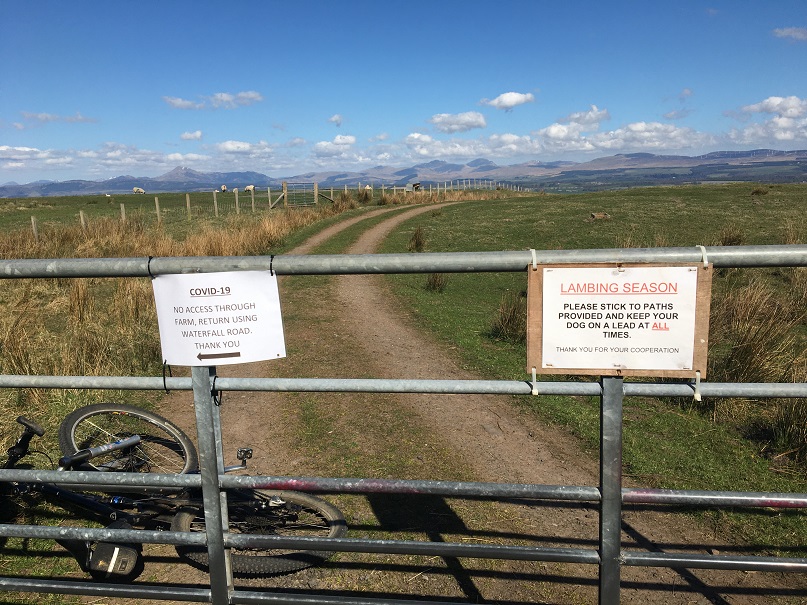
The answer I believe stems back to our failure in Scotland to implement our access legislation as originally intended. While Scotland has lots of forests, moorland and mountains – which should have been treated as a massive resource where people could go safely during this crisis – it has historically had far fewer paths than England, particularly in farmland and around settlements. Agricultural intensification from the 1960s onwards destroyed much of our lowland path network, unlike England and Wales where statutory protection of paths was already in place. As a consequence Scotland’s lowland path density is probably the worst in Europe. That was why the Land Reform Act included provisions for a core path network. The idea was that we should aim to create as many paths around settlements as down south. Unfortunately, due to continued resistance from landowners and austerity, that has never been delivered (see here for discussion of most recent Core Paths plan in the Loch Lomond and Trossachs National Park). Meantime, while the legislation allowed people to walk on fields (see below), in practice patterns of access did not change much. Until now! Many farmers have never really had to experience people exercising their access rights – unlike the big landed estates – and that explains why they are now kicking against them.
All this makes it doubly important that our Local Authority and National Park Access Teams now take swift action against farmers who are trying to prevent people from exercising their access rights. Scottish Natural Heritage, the government body which holds statutory responsibility for access rights and the Scottish Outdoor Access Code, should have a key role in that.
SNH’s guidance on access during the corona crisis
Following the Scottish Government’s advice on access (see here), SNH expanded on this in its own guidance (see here). Unfortunately, this appears to have been unduly influenced by lobbying from farmers and land managers: “During the current emergency, it is understood that land managers can have particular concerns about public access to their land”. What about the rights and concerns of the public?. .
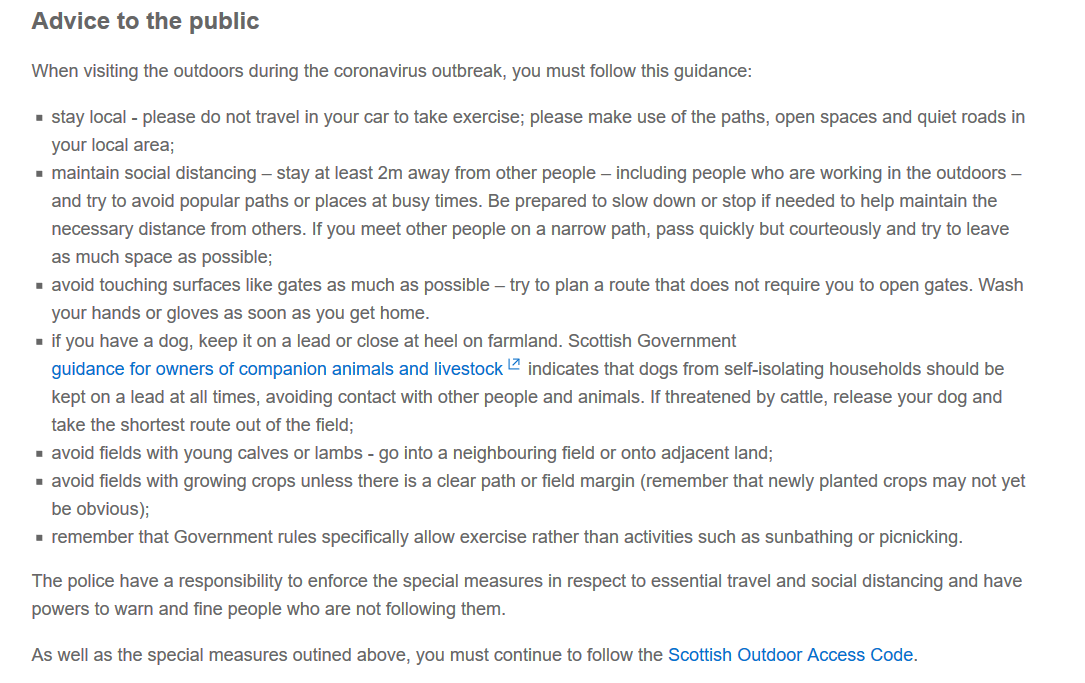
While some of SNH’s advice is helpful and relevant to Covid-19 – like being prepared to stop or slow down to maintain social distance – other parts are less helpful and, very unwisely, it replaces some of the advice in SOAC with something different.
“Avoid touching surfaces like gates” is not very helpful. It doesn’t indicate what the risks are – has anyone bothered to consult public health? – and offers no solutions. Is the advice from NFUS to wear gloves sensible or not, given gloves can carry the virus like hands, or would it be better to “Carry a hand sanitiser if you can”? What about other solutions to minimise contact? I know of people using sticks or the crook of their elbow to open some gates. The advice in the next sentence to “try and plan a route that avoids touching gates”, is almost useless for people living next to farmland. In most areas you won’t get anywhere without opening gates, and very few have hands free catches, so implicitly the message is “keep out the countryside” and an invitation to landowners to say this explicitly.
The Guidance on dogs is just wrong (in the rush SNH may have mixed up this and the succeeding bullet point) and I am staggered NFUS accepted this – perhaps they didn’t bother to read it properly? The section about dogs in SOAC is very clear. It starts by saying “Access rights extend to people with dogs, provided that the dog(s) are “under proper control” (para 3.53) but then goes on to say in Para 3.55 “do not take your dog(s) into a field where there are lambs, calves or other young animals” and that people should ONLY take dogs into fields of vegetables or fruit if there is a clear path (this and other points were included in SOAC to prevent infection risks which were very much in everyone’s mind following Foot and Mouth in 2001).
The following two bullet points, are also contrary to SOAC. The exhortation that people (perhaps SNH meant dogs?) should avoid fields with calves or lambs is contrary to Para 3.30 which is headed “Take care in exercising access rights in fields where there are farm animals by following this guidance” and then goes on to give a number of helpful bits of advice of how to do this. The exhortation to avoid fields with crops without a clear path or field margin is also wrong. Para 3.35 of SOAC starts “You can exercise access rights on the margins of fields, even if these have been sown”. The Code goes on to say that if a crop is being grown in the margin of the field the person(s) taking access should “avoid causing unnecessary damage by keeping close to the edge in single file”
There was a very good reason for the wording of this advice in SOAC, which was the result of considerable debate and was explicitly endorsed by the Scottish Parliament. Given the lack of footpaths in Scotland and the propensity of some farmers to plough up and plant what few paths did exist, it was agreed that the only way to guarantee people’s access through farmland was to ensure that everyone had a right to walk through fields, subject to following the SOAC. This fitted very well with the environmental thinking at the time, which was that in order to provide some habitat for wildlife there should be a wildlife corridor around each field. In other words field margins should be able to be enjoyed by both wildlife and people. Hence this advice for land manages in SOAC: “leaving uncultivated margins can help people to exercise access rights responsibly and to help to support wildlife so it makes sense, wherever possible, to do this”. (The debate that took place on this at the Justice 2 Committee on 18th September 2002 (see here) should be essential reading for all Access Officers and anyone else interested in understanding this issue. At Stage 3 the Scottish Parliament passed a further amendment which clarified access rights cover fields margins, whether sewn right to the edge or not).
Sadly, from an environmental perspective, what’s happened since is that unless farmers get paid to keep field margins, they tend to plough them up. This leaves nowhere for wildlife or potentially for people. That’s why the wording of SOAC is so important and we need to re-inforce it at every opportunity. Indeed the right of access around the margins of fields arguably should have come into its own since people have been told to exercise from home. If the field behind your house is totally ploughed up and planted, that’s fine, you can still walk or bike or ride a horse around the margin.
SOAC has stood the test of time, with no changes needed over the last 15 years.or now. It was infection control proofed from the start, based on the FMD experience. Unfortunately SNH appear to have forgotten this history and what was agreed by the Scottish Parliament in their approval of SOAC. The result is an incorrect interpretation and application of SOAC to Covid 19. What they should have done is re-emphasised SOAC as the basis for outdoor access, supplemented by additional requirements (2 metre separation plus care in gate handling) to reduce the risk of spreading Covid-19 while exercising access rights.
Buried in the middle of SNH guidance is a sentence which proves this point:
“Land managers can be reassured by current UK guidance which suggests that the risk of the coronavirus being passed on to others from people using paths is considered to be very low, as long as people follow the Government’s instructions to maintain social distancing.”
That confirms exactly what Parkswatch has been arguing, that we should be encouraging and enabling everyone to go out into the outdoors – its a safe place to be – and there is almost no risk of spreading the virus if people keep 2m apart. It makes me suspect that the rest of the advice has been driven by political considerations rather than science or respect for access rights. Its worth saying, that is NOT the fault of the frontline staff working on this, the responsibility lies with their leaders.
Civil liberties and access rights
While SNH’s job should be to relate COVID- 19 to the requirements of the 2003 Act and SOAC, like other agencies they have taken it on themselves to promote the Scottish Government line that people should not now drive to take exercise and should limit going out to once a day. Neither of these pieces of “advice” are law.
Ten days ago, in England, the National Police Chief Council and College of Policing issued advice, based on the recommendations of the Crown Prosecution Service, that driving for exercise IS permitted under the law (see here for explanation in Guardian. The advice (see here), informed by the law on human rights, appears to been adopted by police forces in England and implicitly acknowledges some of the initial policing (e.g drone surveillance in the Peak District) may have been heavy handed:
“Some public statements made soon after the adoption of the Regulations suggested that members of the public could only leave their homes if ‘essential’ to do so. However, this is not the test set out in the Regulations and there is no legal basis for a requirement in those terms to be imposed. The applicable threshold is that of ‘reasonable excuse’. The summary of what people is reasonable UNDER THE LAW AS WORDED is worthy of wide circulation:
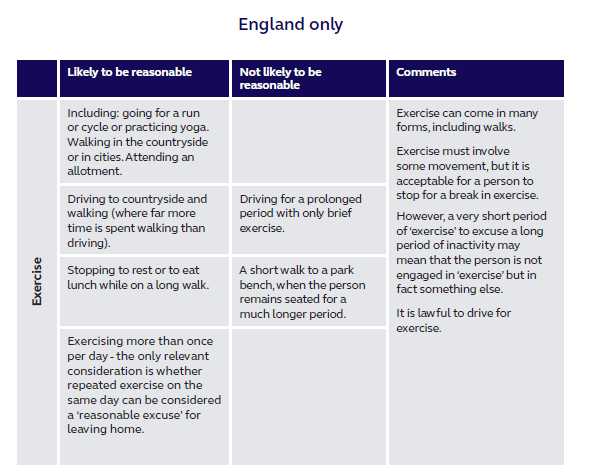
So why haven’t Police Scotland and Scottish Government issued a similar clear public statement of what is allowed under the law in Scotland? And have any of the 1600 Fixed Penalty Notices that the police have issued for people breaking the regulations (mainly apparently for house parties (see here)) been issued to people driving to take exercise?
The message coming from government in Scotland that people shouldn’t drive for exercise – and associated with that the closure of public car parks – is having serious adverse consequences. Its needlessly concentrating people in certain areas, its contributed towards dog walkers entering fields with animals close to where they live and its contributed to the general panic by implying that somehow Covid-19 gets spreads by cars. There is no evidence that people are more likely to spread Covid-19 by getting in a car to go for a walk or a bike ride than they would by walking direct from home. The lack of understanding, however, then contributes to people’s reluctance to seek medical treatment which I highlighted at the start of this post, not least because people are concerned about their neighbours reaction if they are seen to get into a car, whether this is to seek medical treatment or anything else.
Earlier this week the Scottish Government issued a set of amendments to The Health Protection (Coronavirus) (Restrictions) (Scotland) Amendment (No 2) Regulations 2020 (see here). The main change to the existing regulations was a tweak to make it easier to enforce the physical distancing rules in workplaces (welcome) and a slight relaxation which allows burial grounds and the areas around crematoria to be open to the public (though the rules on “gatherings” still apply). There were NO changes to the provisions about when people can leave their houses. While it’s very disappointing that the government did not add “mental well-being” to the list of reasonable excuses for leaving where one is living, the important thing to note here is that there has been no change in the law as regards driving to take exercise. My conclusion is that it’s still quite lawful to drive to take exercise in Scotland.
What needs to happen
In summary:
- To achieve essential clarity and stop the panic, the overriding message from government to the public should be it’s safe to be outdoors as long as you can observe 2m physical distancing from people who are not members of your household and that driving in itself will not spread the virus
- The Scottish Government and Police Scotland should issue guidance on driving for exercise like the Police Chiefs have done in England (see above).
- SNH should require NFUS to amend its misleading standard signs and should amend its own guidance so that both properly reflect the SOAC and the 2003 Land Reform Act. It should seek advice from public health on how best to manage the very small risks associated with spreading COVID-19 that could arise from touching hard surfaces (like gates) in the countryside. That medical advice plus the 2 metre physical distancing requirement should be built into the SNH amended advice.
- SNH should be reminding all Access Authorities of their legal duty to remove signs that have gone up as a result of Covid-19 and contravene the SOAC and asking them to document the extent of such signs in order that the question of how we can prevent this happening in future can be properly considered by the Scottish Parliament. Such work by Access Authorities should be regarded as “essential work” as defined by the Covid 19 requirements and should involve driving, if necessary.
- The Scottish Government, SNH and our National Parks should, in response to increased use of farmland around settlements, develop a new plan to implement the vision behind the 2003 Act, based on ensuring there are unplanted margins around every field and a huge expansion in the core path network. That would set a good example of the type of new world we should be aspiring to.

If we thought that devolution would reduce the amount of “designed for London” legislation and thinking, we should have realised we would only swap it for “designed for Edinburgh”, there is no practical difference.
In North Lanarkshire it doesn’t matter that the UK government has stated clearly that you can drive to take exercise, the Council and the Police have made sure that any suitable car parks are locked or blocked off.
Pre Covid 19 I have tried to get two Scottish councils to deal with access issues, in both cases it was a waste of time.
Lots to think about Nick..thank you again.
One lesson life teaches is how easy it is to say “NO, you can’t” and how hard it is for some people given authority to think through a snag, to find ways to say “Yes, you may, if you do this”. It is time to move the message on from: “Save the NHS”, towards identifying mechanisms that will save our national and regional economies. We will not manage through next winter unless our essential infrastructure is serviced and repaired, and more people are permitted – under special provisions- to resume their various employments very soon indeed . The currency devaluations and years of taxation that will be required to repay this splurge of Government lending has not even entered the public consciousness yet. …and yet it must. .
It has become so much easier to say “No”. “Ban this, prohibit that” The consequence of being the one official or organisation to say “yes” can be redirected every time up the “chain of command” instantly..This will not get us out of this situation well at all. .
Who doubts we now exist in a total limbo of indecision because those ultimately in charge of local policy dare not be seen to risk being identified personally as the ones responsible for any more mistakes?
All perfectly correct, and clearly observed; the tipping point regarding the ill-health suffered in, and caused by the largely nonsensical “stay at home” policy is approaching, in many regards. I note in the Scottish Government’s recent publication of the way on (https://www.gov.scot/publications/coronavirus-covid-19-framework-decision-making/pages/7/) Section 5, para 7, that “outdoor activities” are regarded as possibly being an area for the early lifting of restrictions. So in addition to the mounting levels of ill-health accruing, and pardon my cynicism, but as the red stag season starts on July 1st, is pressure being brought to bear to open the Highland hunting, shooting & fishing season as normal, and by then? If so, what might be the arguments in law against general access being granted? I wonder (Andy Wightman’s hill tracks Planning Bill Amendment defeat being an example) just how much the SNP might be influenced by landowners and the traditional Highland (and elsewhere) establishment.
Well argued piece – the kernel of the whole issue is that the ‘stay at home’ message is effectively a proxy for social distancing, which is what actually reduces the transmission rate. I suspect that the authorities know it’s illogical but fear that anything other than the simplest of messages and slogans will lead to chaos – I think they are wrong, but convincing them otherwise in the current zeitgeist is an uphill battle.
Meanwhile, back here in Wales…
I think the Welsh Assembly Government is to be congratulated for at least sharing its early views on a potential exit plan from the current lockdown, but its unwillingness to consider regional variations is a missed opportunity. In a mirror of what must be the case in Scotland, large areas of rural Wales are in an entirely different situation to the urban South – rates of infection are materially lower, as are fatalities across the whole of the West, Mid and Northern counties. These areas are not behind the curve – rather, they are on a different curve entirely. And yet the lockdown – and all the negative consequences that come with it – is just as complete.
Surely it is not beyond our wit to make allowance for this? Why for example, should schools remain shut in Pembrokeshire, or local businesses remain closed in Aberystwyth? The reality is that when the exit plan tests are met and restrictions eased, the infection rates in urban areas will still be higher than they are now in their rural counterparts. Consistency is often a virtue – but in this case, it is a high price to pay as rural areas wait for the infection rates to decline in their urban cousins.
I live in a tenement flat, under 40 but most the residents in the block are between 50 and 90, we clean common areas everyday, and make sure the bins are clean for our own health and council workers, we share a small communal garden but limit use to ensure every residents can get use of it while maintaining social distancing, and before entering and leaving my flat I look out for my elderly neighborhours, if we can keep each other safe, despite residents working on the front line being exposed to the virus, then I am sure the rural country side can be kept safe, with a common sense approach access to fields and through gates should be extremely
Safe with no risk at all. I carry antiseptic wipes for gates, as I am sure many other do. Please stay clear from farm yards and buildings, but if a random field a long distance from any building has had unrestricted access prior to cornavirus then such access shouldn’t change now. If people can live together in high rise flats and tenements then, access through fields should never be a problem.
In Germany now travel through farm land is a joyous experience, with all crop land verges having a 5 meter wild flower border, very beautiful to see in summer with an abundance of butterflies and pollinators, no reason why such a law could not be implemented here.
Yes, we need such 5 metre margins in Scotland, for wildlife habitat protection, carbon capture and public access. Farmers have demonstrated over the last 15 years, since uncultivated margins were recommended in the Scottish Outdoor Access Code, that they are not prepared to leave these when planting new crops. Covid 19 is demonstrating conclusively that much better regulation of Scottish farming should be a top priority in future. FIve metre margins should become a statutory requirement. No margins should equal no public subsidy. Bring it on!
A well argued blog with the relevant references to back up your statements. Yes, our politicians have been modifying the guidance to go further than the UK regulations. Our Scottish ‘nanny state’ has been putting forward the keep it simple, stupid line. Maybe there was some need for that in the early stages – just to get a strong message across – but as we contemplate of gradually coming out of the restrictions, there needs to be a much more sensible and science based approach. You have pointed out, Nick, the many anomalies in the guidance/regulations. This is the time for these anomalies to be corrected ……. and give our politicians an easy way of showing that they are taking the first step to loosen the restrictions (pardon my cynicism).
Another anomaly came to me recently in the P&J article about the enforced closure of Foxlane Garden Centre by Aberdeenshire Council – see https://www.pressandjournal.co.uk/fp/news/aberdeenshire/2168050/kick-in-the-guts-for-owner-of-aberdeenshire-garden-centre-forced-to-close-only-a-day-before-huge-queues-outside-bq/. A small garden centre employing disadvantaged people has to close, whilst B&Q can open and sell plants.